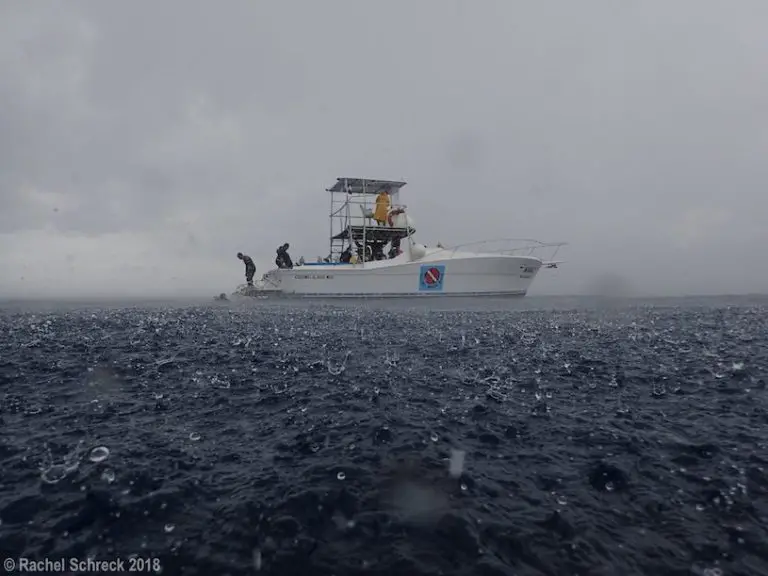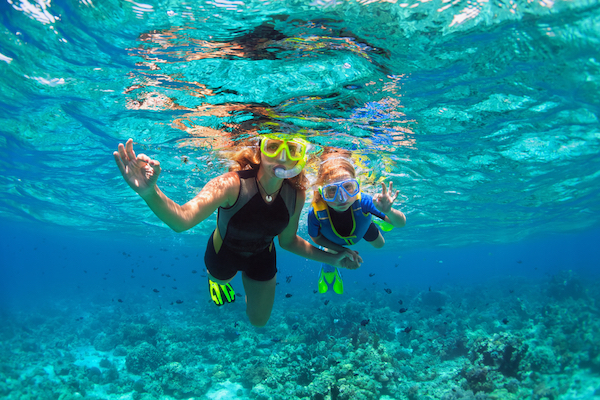Sea Turtles in Cozumel: Your Full Guide
Cozumel is the perfect place to dive and swim with sea turtles, and even join in on volunteering at the local Cozumel turtle sanctuary to help protect a couple of the local marine turtle species.
Here’s your full guide to encountering everyone’s favorite marine creature, information on where to see turtles in Cozumel, and more.
Cozumel, Mexico is home to three of the seven remaining species of sea turtles, including the loggerhead turtle, the hawksbill, and the green sea turtle. Scuba divers will most commonly encounter hawksbill turtles, followed by green turtles, and then a handful of resident loggerheads. Non-divers can swim with sea turtles at one of our many snorkeling spots. Cozumel also has authorized volunteer programs to help turtle nests and baby hatchlings.
If you’re a turtle fan, Cozumel is a great place to visit. While there are no guarantees with wildlife, it is quite common to encounter sea turtles when scuba diving in Cozumel’s national marine park dive sites.
You will certainly interact with sea turtles if you join one of the official turtle nesting and hatching experiences in the summer months.
Turtle-loving snorkelers or swimmers may have the lowest odds, but they very often luck out and observe turtles eating and resting on the coral reefs or ascending to the surface for some air.
Existing Sea Turtles Found in Mexico
There have been eight kinds of sea turtles in existence on Earth.
One ancient variety, the ‘Archelon”, was very large (up to 13-15 feet/4+ meters in length). But the archelon is truly a dinosaur, dating back to the Cretaceous period, and has been extinct for many millions of years.
So that leaves seven modern-day sea turtles.
Mexico overall is home to six of the seven remaining species of sea turtles.
The one modern-day sea turtle that is not found in Mexico is the “flatback” sea turtle (natator depressus), which has a very small range and currently is found only in the Australian region.
The remaining six species of modern sea turtles that are found within Mexico:
SEA TURTLES OF MEXICO | ||
| Hawksbill | eretmochelys imbricata | critically endangered |
| Green | chelonia mydas | endangered |
| Loggerhead | caretta caretta | endangered |
| Kemp’s Ridley | lepidochelys kempii | endangered |
| Olive Ridley | lepidochelys olivacea | endangered |
| Leatherback | dermochelys coriacea | endangered |
The leatherback turtle is the only modern turtle that is classified in the Dermochelyidae taxonomy family, and its main distinguishing feature is that its carapace, or protective shell, is made of thick tough flesh – like thick leather – rather than a hard shell.
The other extant sea turtles, including all of the sea turtles found on Cozumel, are in the Cheloniidae family and have rigid, bone-like carapace shells.
Sea turtles’ carapaces vary in shape, markings, and the number of ‘scutes’ or sections of each shell.
This diagram from a study, The Anatomy of Sea Turtles, by Dr. J Wyneken at Florida Atlantic University shows the distinctive shapes, quantities, and other features that allow researchers – and casual observers – to tell the differences among the different sea turtle types:
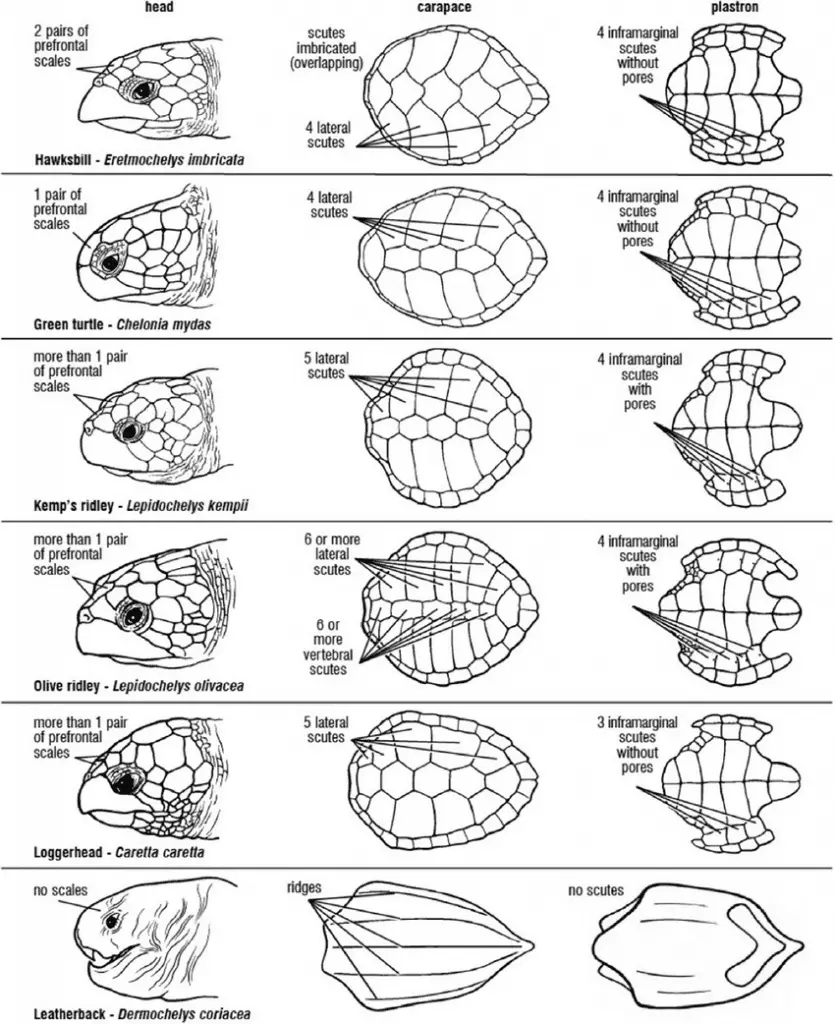
The overall differences among our living sea turtles are also made very clear in this fun and informative illustration from the Smithsonian Institute’s Ocean education site:

Leatherbacks and Kemp’s Ridleys are often seen in Florida, the Gulf of Mexico shores of both Texas and Mexico, and even along beaches in the upper Yucatan Peninsula and Cancun, but are not reported as far south as Mexico’s Cozumel island.
The Olive Ridley is more a Pacific Ocean dweller so is not found in Mexico’s eastern coast of the Yucatan Peninsula.
That leaves Cozumel, Mexico with a good representation of the other three kinds of sea turtles. Hawksbill sea turtles, green sea turtles, and loggerhead sea turtles are quite frequently spotted here, especially by recreational scuba divers.
Are Cozumel Turtles in a Marine Protected Area?
Cozumel is a valued natural environment and has domestic protection from Mexico’s ministry of natural resources and the environment (SEMARNAT).
The coral reefs and southern mangroves have the additional designation as a protected national marine park, the Parque Nacional Arrecifes de Cozumel.
The mangrove areas in the northern section of the island, and the national marine park above, are both listed among UNESCO’s 1971 Ramsar Convention on Wetlands sites of international importance.
According to Ramsar’s annotated summary of Mexico’s sites:
The (national marine) park is habitat to numerous endangered species, such as the Loggerhead (Caretta caretta), Hawksbill (Eretmochelys imbricata) and Green (Chelonia mydas) turtles, the Queen triggerfish (Balistes vetula) and the endemic Splendid Toadfish (Sanopus splendidus). Lobster, crab and pink conch Strombus gigas are commercially fished, populations of the latter having recovered following a prolonged fishing ban.
Cozumel is also one of the early “hope spots” designated by Mission Blue, the initiative to create a global network of MPAs (marine protected areas) led by renowned oceanographer and scuba diving icon Dr. Sylvia Earle.
Beyond the marine park, the south and east shores of the island serve as the Cozumel turtle sanctuary, of sorts, and different beaches are natural nesting sites for the green sea turtles and the loggerhead sea turtles in Cozumel and beyond.
Despite these protections in place for the marine environment, and the protected status all sea turtles have globally under the UN’s Convention on International Trade in Endangered Species of Wild Fauna and Flora agreement (or “CITES”, which is also emphasized by the UN’s annual World Wildlife Day awareness campaigns), Mexico alone has approximately 2,500 species listed in the CITES appendices of threatened animals.
Unfortunately, this includes all of the Mexican sea turtles, and they are all listed in CITES “Appendix 1”, meaning they are classified among the “primary” list of the most endangered animals that face ongoing threats.
Cozumel Turtles include Several Sea Turtle Species
While this global picture is pretty bleak, scuba divers in Cozumel still enjoy frequent organic encounters with sea turtles in Cozumel, especially in the national marine park.
The sea turtles you’ll see when diving in Cozumel are typically adults and quite large in size. There are occasionally young (and very cute) green turtles and hawksbill turtles swimming around, though.
You can tell the young ones simply because they are smaller (say, the size of a large dinner plate) than the average adult sea turtle sizes and weights listed below:
Sea Turtles Found in Cozumel, Mexico | |||
| Species | Length | Weight | Diet |
| Hawksbill | 30-45” / 90cm | 90-175lbs / 40-80kgs | Omnivore |
| Green | 30-60” / 95cm | 150-700lbs / 70-300kgs | Herbivore (once adult) |
| Loggerhead | 36-48” / 100cm | 250lbs / 115kgs | Carnivore / Omnivore |
The most common local turtle, and yet the most critically endangered on this list, is the hawksbill sea turtle.
Hawksbill Sea Turtles in Cozumel
Hawksbill turtles range in size and often grow to be quite large. I have seen a few while diving that are at least 5 feet/1.5m long, and about 3+feet/1m wide.
They have a sharp, pointed beak – hence the name, hawksbill.
Frequently, you’ll see this Cozumel sea turtle using its hawksbill to break up hard corals and bite off pieces of sponge or to grab and chomp down on conch shells or other crustaceans. Like loggerheads and juvenile green sea turtles, they will also eat jellyfish, if available.
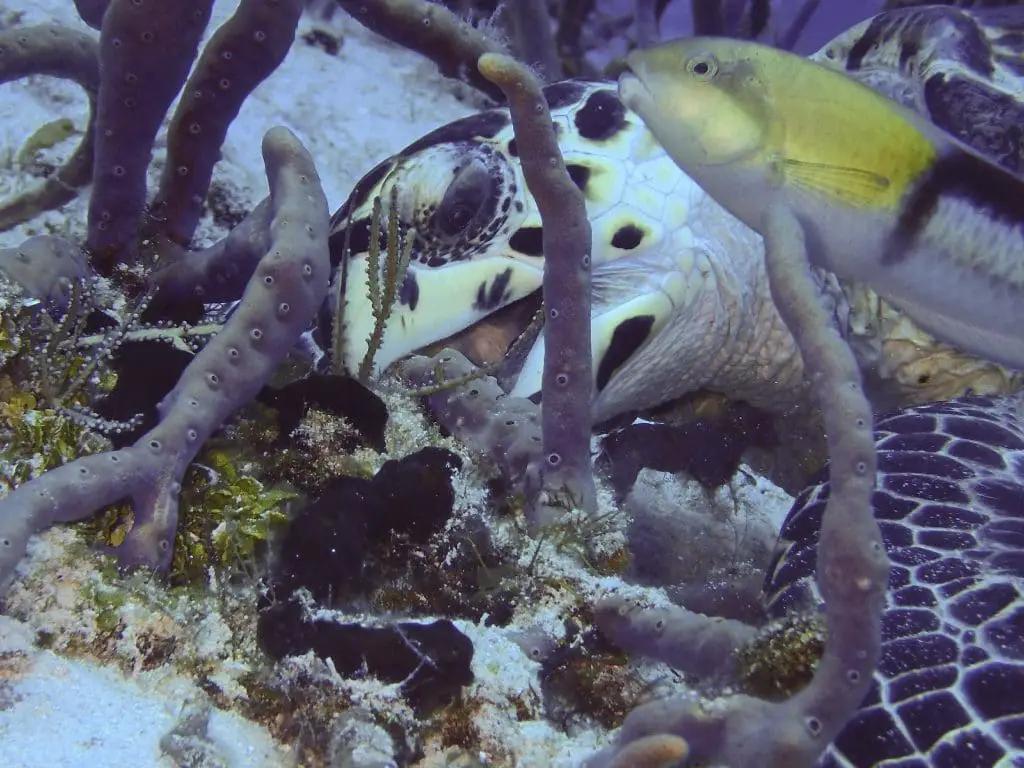
Hawksbills have white skin with yellow and black areas, and their head and carapace shell have largely black color patterns, with some reddish-brown and caramel coloring.
Unfortunately, this classic “tortoiseshell” appearance is what makes the critically endangered hawksbill turtle so attractive to poachers. (Read on to the end for more on the main threats to this and the other sea turtle species.)

While hawksbill turtles in Cozumel are the most common to see while diving here, we are also seeing more and more green sea turtles along the reefs of the marine park.
My top Cozumel dive sites for spotting hawksbill sea turtles are Palancar Bricks, Cedral Wall, and…really every single dive site!
Green Sea Turtles in Cozumel

The green sea turtle (above) is also one of the two main species of Cozumel turtles that nest and hatch on the island’s eastern and southern beaches.
The green sea turtle variety is so-called because as adults, they typically become strict herbivores, and therefore the fat deposits under the skin take on a green hue.
Green turtles are just beautiful, and almost seem to take pride in that fact. They keep their pretty shells very clean and are frequently seen rubbing up against soft and hard corals – perhaps to scrape off any debris or parasites.
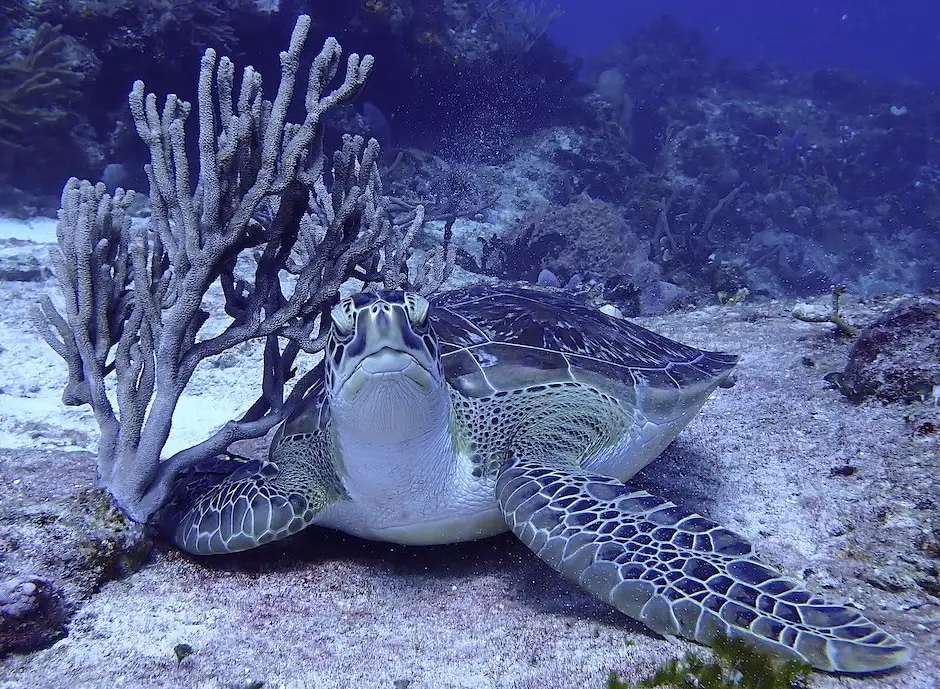
Unlike the hawksbill and the loggerhead turtles, which as you can see in some of the images in this post allow algae and even barnacles to grow on their shells, green sea turtles in Cozumel almost always have a smooth and unblemished shell of almost painterly shades of brown, cream and even purple colors.
My top local dive sites for spotting green sea turtles are Palancar Gardens, Tormentos, and Dalila.
Loggerhead Sea Turtles in Cozumel
Finally, another sea turtle species that lives and nests around the island is the mighty loggerhead turtle.
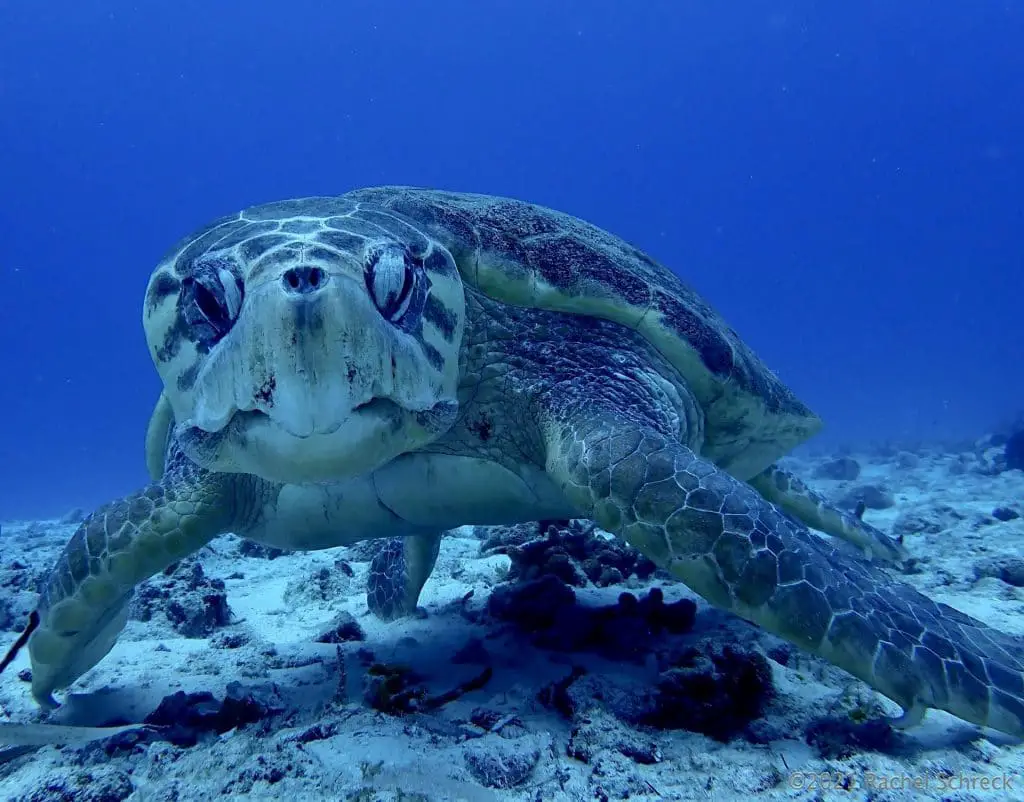
When you encounter a loggerhead turtle when diving, you will know it.
The ones that take up residence here in the Cozumel marine park all seem to be very old and very large.

Unlike the green sea turtles’ shells, the loggerheads’ shells are often full of old-growth algae and have barnacle shells along for the ride.
Several here even have distinctive scars and marks of past injuries (likely from boat propellers), making them identifiable. Definitely sad, but also a testament to their strength and survival skills.
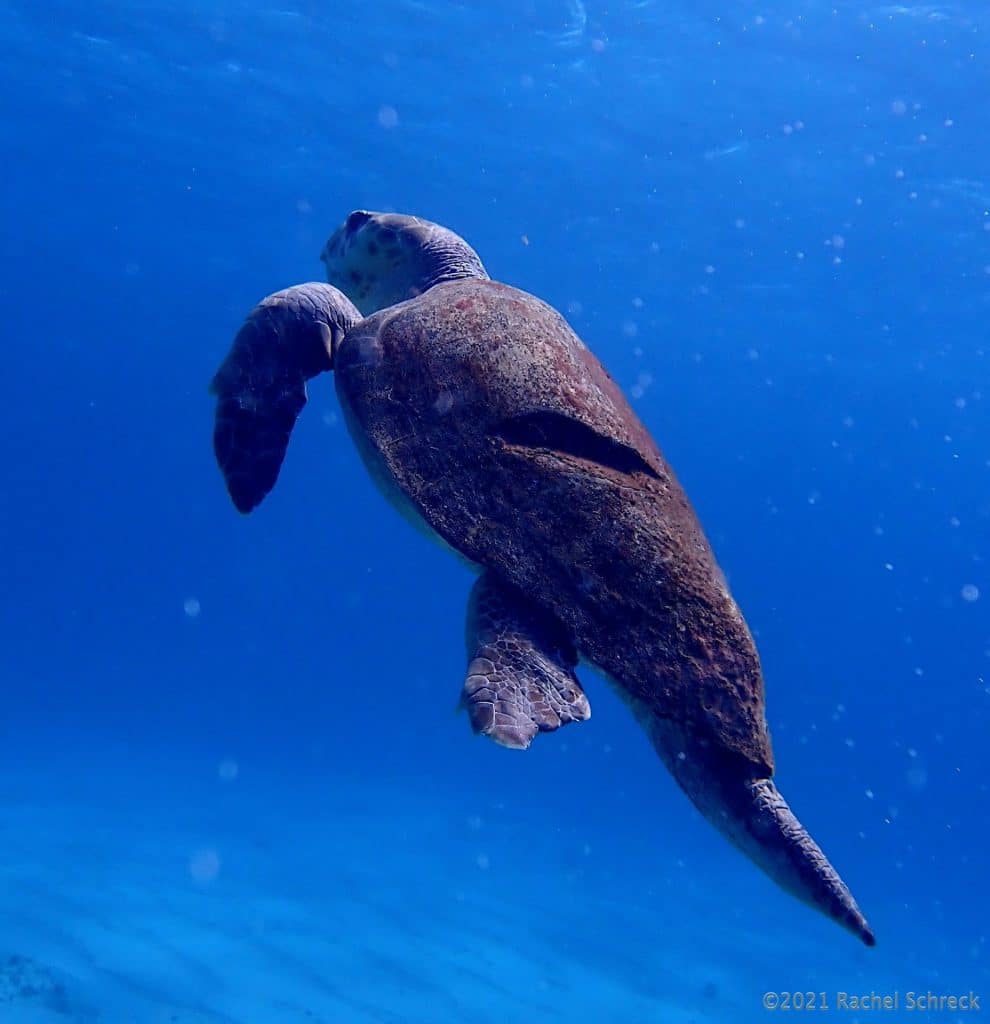
Scuba divers can definitely bump into a huge loggerhead sea turtle in Cozumel on any of our reefs, though based on my experience, loggerhead encounters are less common than with the greens or the hawksbills.
My top dive sites for spotting loggerhead sea turtles, historically, are Cedral Pass, Santa Rosa Shallows, and San Francisco Wall.
If you’re interested in volunteering to help Cozumel’s sea turtles, keep reading for more information below. Hundreds of green sea turtles and loggerhead sea turtles both lay thousands of eggs on the southern and eastern shores every summer, and volunteers help guard the designated Cozumel turtle sanctuary areas, record the nests, protect them, and help shepherd new baby hatchlings to the open ocean.
Diving With Sea Turtles In Cozumel
You can dive with sea turtles in Cozumel, and the best part is, you can see them along any of the island’s very common and accessible dive sites.
I’ve seen countless turtles on every single one of the dive sites, from the deeper southern reefs of Punta Sur and Colombia to the most shallow sites like Francesa and Yucab.
By the way, shallow dive sites are often dismissed by divers who think deeper dives are somehow better, but I (and several hundred of my friends) can attest to seeing far more turtles (and sharks and rays and eels and pretty reef fish and invertebrates…) on shallow dives, than deeper ones.
Also, at shallow depths, sea turtles are usually more active: they’re busy foraging among the coral and sponges, snacking on jellyfish, and interacting with the angelfish and other reef fish that follow them around, hoping for scraps. In my opinion, overall you get a much better show.
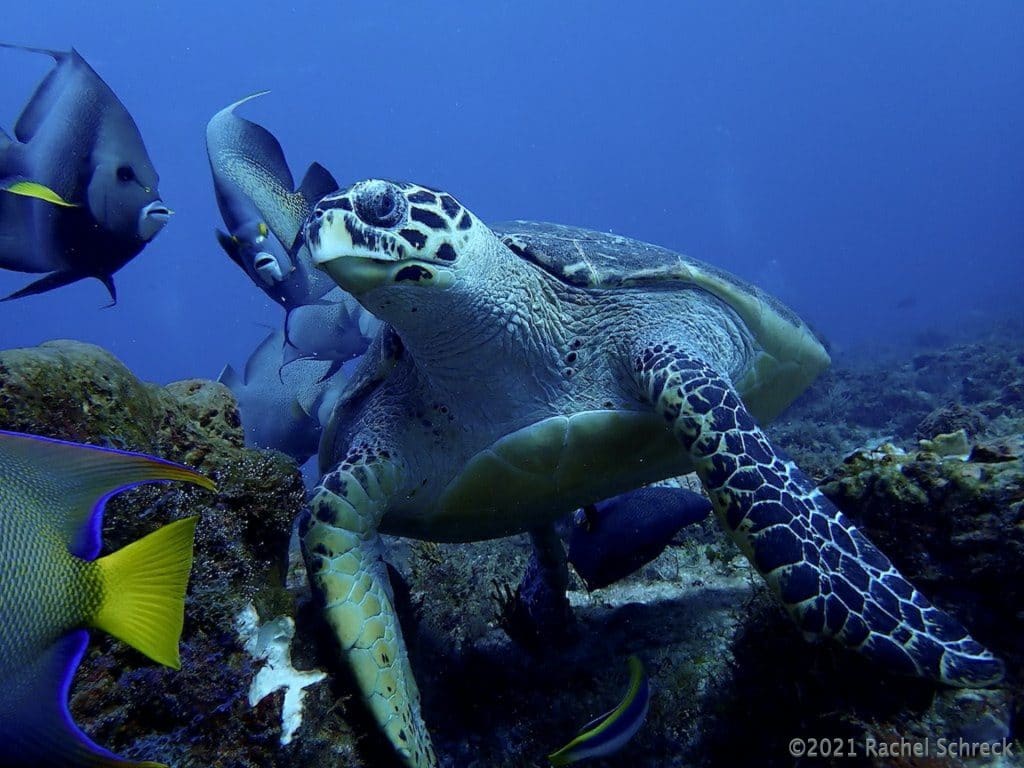
That said, some of the best dive sites to encounter Cozumel turtles are those in the main Palancar section of the marine park – namely, Palancar Caves (Cuevas), Palancar Bricks (Ladrillos), and Palancar Gardens (Jardines).
There is also an excellent chance of seeing large hawksbills and loggerheads in the Paso de Cedral and Dalila areas.

Cozumel Divers! While you’re looking for turtles on your dives, be sure to keep an eye out for our other special endemic species, the Cozumel Splendid Toadfish. Read all about them, here.
Snorkeling With Sea Turtles in Cozumel
As mentioned above, swimming and snorkeling in Cozumel are awesome, but you might have a lesser chance of running into a sea turtle than you would on a dive. Unfortunately, we can’t call them on cue!
For your best odds, though, a boat-led snorkeling tour will take you out further offshore, to snorkel over some of the prime shallow-reef dive sites, like Colombia Shallows, Paradise, or San Clemente.
This can result in a chance to swim with turtles in Cozumel, especially if one comes up to the surface for air.
There are plenty of specific locations, but the main thing is to look for an off-shore boat snorkeling operator that will take you to a good area of the coral reef – rather than just a nice sandy beach area. This will allow you to have a better chance of seeing some Cozumel turtle species that live among the coral ecosystem and don’t tend to come closer to shore.
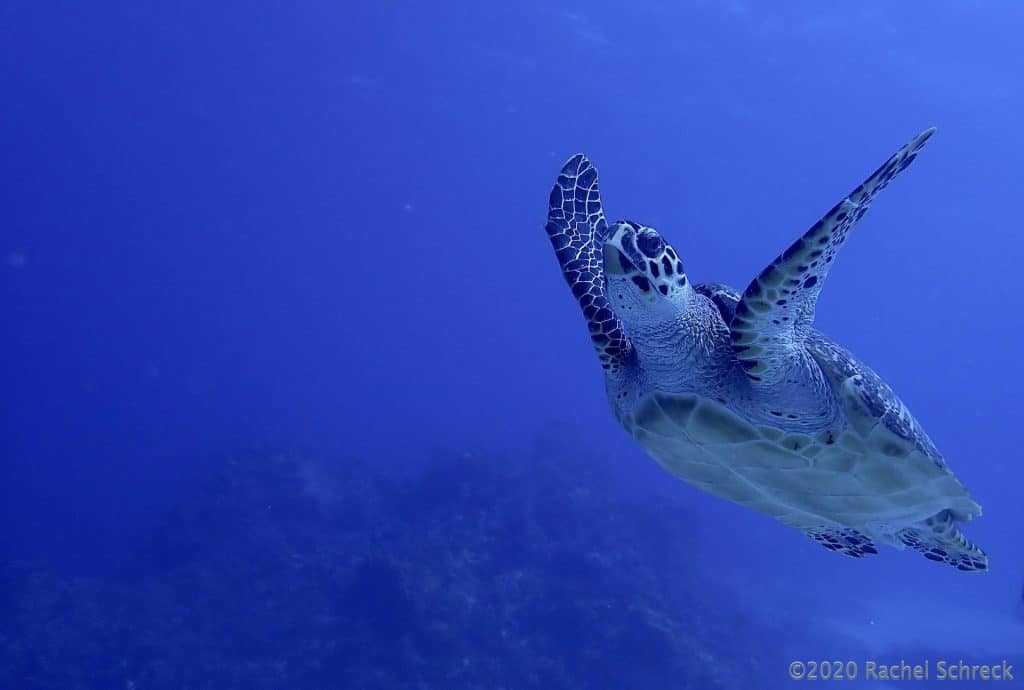
Sea turtles in Cozumel are more likely to hang out along the reef, where they find more food, rocky overhangs to help them scrape and clean their shells, and crevasses to hide out and rest.
A boat-based snorkeling tour in Cozumel will also give you a better shot at getting glimpses of other large marine life, like sleeping or cruising nurse sharks (harmless), or large stingrays, moray eels, an abundance of tropical fish, including larger reef fish, like the rainbow parrotfish or big groupers and barracuda.
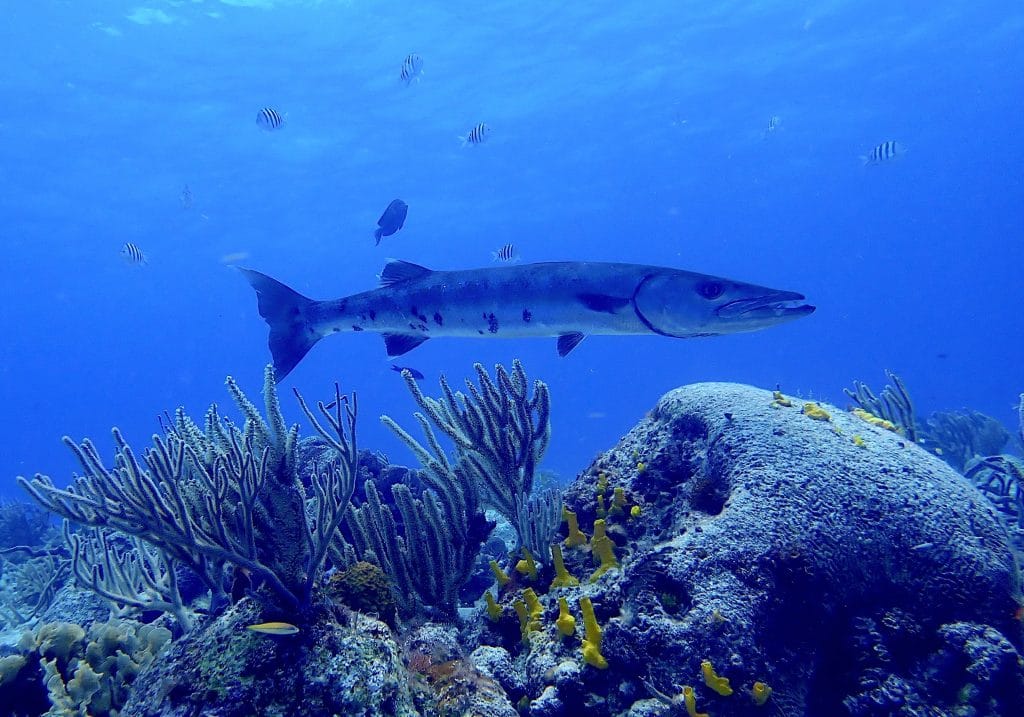
If you don’t want to board a boat, though, no worries. There are lots of good snorkeling spots that are easy to get to and offer good access to smaller coral formations and busy marine life.
First off, check with your hotel or accommodations.
Many of the cool dive resorts in Cozumel or the large waterfront hotels in the northern hotel zone have great swimming areas right on their grounds, and they can advise you if it’s good and/or safe for snorkeling.
Alternatively, they may have agreements with certain local beach clubs where you might enjoy a discount as their guest.
Next, I would recommend trying Chankanaab Park’s beach for snorkeling.
Chankanaab Park is one of the large parks run by Cozumel’s Museum and Parks Department, so you can count on good service, well-kept facilities, and high-quality amenities. There is an entrance fee (as of Feb. 2021 it is $26USD for adults and $18USD for kids 4-12), but it includes lots of bathrooms, showers, hammocks, beach chairs, a playground for kids, beach waiter service, parking, cultural and educational displays, various restaurants and snack bars, a spa, some sea life shows, tequila tastings, and more.
And Chankanaab, at its heart, is a nice big beach with small palapa stands (thatched huts) to borrow snorkeling gear – or even sign up for your first “Discover Scuba” experience, if you want. The beach has several access points and is right in front of a large shallow dive site, so the snorkeling area should be pretty lively, yet still very easy and safe.
Some other good snorkeling spots to get you close to the marine park action are Sky Reef, Buccanos, and a perennial favorite, Playa Corona.
Playa Corona has a long reputation as a humble place, but with some of the best snorkeling in Cozumel – just be sure to swim out a ways to the small drop off, where their house coral reef lives (that’s where the best marine life will be!).
Do Sea Turtles Attack or Bite Humans?
I’ve been surprised by the number of people who have asked me if sea turtles are dangerous or aggressive and if it is safe to swim with sea turtles. From personal experience, Cozumel turtles are not aggressive and mostly either avoid divers or don’t seem to even notice we’re there.
That said, they do have very powerful jaws that are strong enough to crush thick conch shells, among other things, so I get it. Especially if you’re new to diving, snorkeling, or just swimming in the open ocean and wondering what lurks beneath you.
It is safe to swim with sea turtles. Encountering a sea turtle in the wild will be a happy coincidence – they are not prone to approaching or pursuing humans. Sea turtles will mainly avoid you if you are swimming or snorkeling near them.
As with any wild animal, though, if you approach one or get too close, there is a chance the sea turtle will sense a threat and try to protect itself by any means necessary – namely by biting or simply retreating.
Sea turtles have unique senses, also, including a keen sense of smell, questionable vision, and nerve endings within its carapace (or shell) so touching one may seem harmless, but could create a bad reaction.
Be respectful of their personal space and habitat, and don’t get too close, nor stick anything (especially your hand!) anywhere near it.
Please Don’t Feed the Wild Animals in Cozumel
Finally, please note that you should definitely not feed anything to a Cozumel sea turtle – or any wild animal in Cozumel.
This advice includes a request that you do not do seemingly harmless things like chucking your apple core or banana skin off of a dive or snorkel boat when you’re snacking. Yes, these items are biodegradable but they are not appropriate to the marine animals’ diets. Don’t litter, period.
When Do Turtles Nest and Hatch in the Cozumel Turtle Sanctuary?
Each year, from approximately May to October, thousands of baby sea turtles nest, and then hatch, ready to start their lives from Cozumel’s southern and eastern shores.
Some ten to twenty years later, those same turtles return to lay thousands of new eggs in deep nests that they dig into the sandy beach areas of Punta Sur Eco Park, and along the wild eastern coastline, known locally just as “The Other Side.” These two main areas basically become the Cozumel turtle sanctuary.
The Cozumel turtle hatching season is roughly from August through early October.
The two main species of sea turtles that make their nests on Cozumel are the loggerhead turtle and the green turtle. See above for the overall characteristics of these two turtle types.
Make sure you choose from the programs approved by the island’s parks and ecology departments!
Visitors and residents can pitch in to help mark and record the nesting sites, as well as assist when the young hatchlings emerge and make their way to the ocean.
But be forewarned, not all of the Cozumel turtle excursions are official Cozumel turtle sanctuary programs. There are some tours led by cruise ships that may not follow all of the local conservation protocols.
Ask your hotel to help you, or to be sure just follow this link to the “Sea Turtles Workshop” experience, and/or look for the official FPMC logo, seen here:

Cozumel Sea Turtle Nesting Process
The sea turtle nesting season in Cozumel typically starts in May when the mature mother turtles navigate by Earth’s magnetic fields to return to their home beach, in an amazing process called natal homing.
Once up on shore, an adult sea turtle will use its rear flippers to dig holes in the sand, approximately 10-12″ (30cm) deep, and deposit around one hundred ping-pong-ball-sized white eggs.
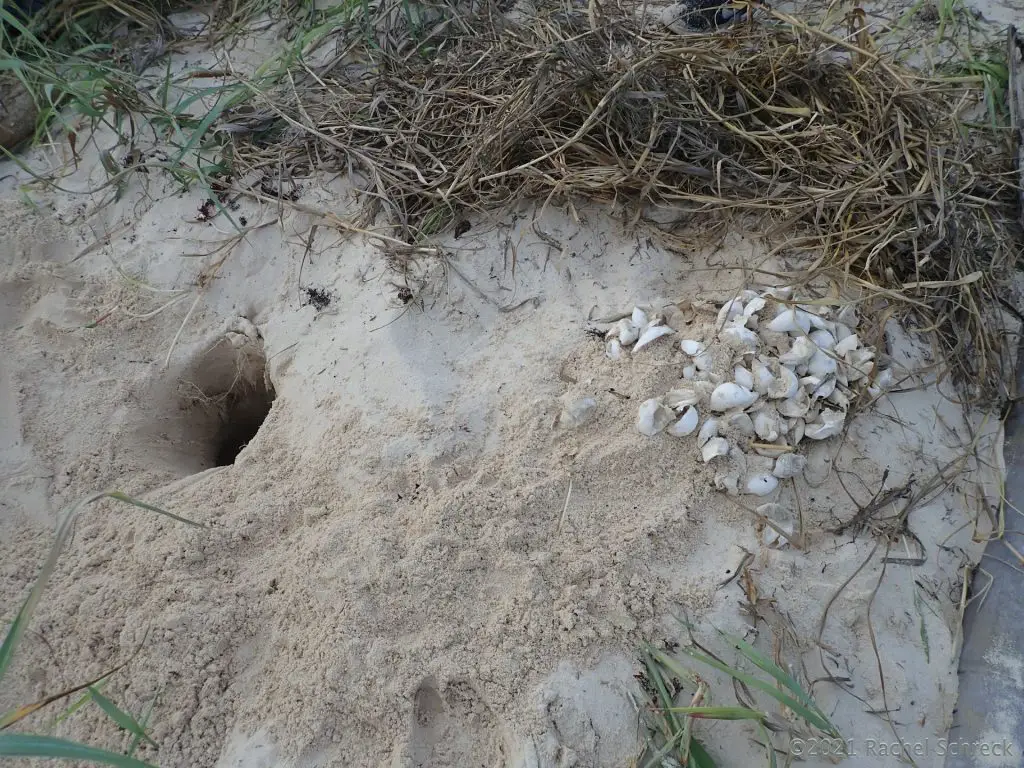
The adult turtle then fills in the hole with sand, again using her flippers. The turtle often packs down and “hides” the nest location using sweeping motions with her underside to help the nest blend in with the sand around it.
Then, she returns to the open ocean. (When I watched a ridley sea turtle lay a clutch of eggs in Costa Rica, the whole process took approximately one hour).
This cool graphic from the Florida Fish and Wildlife Commission might help you distinguish which species’ nests you’re spotting, after the fact:
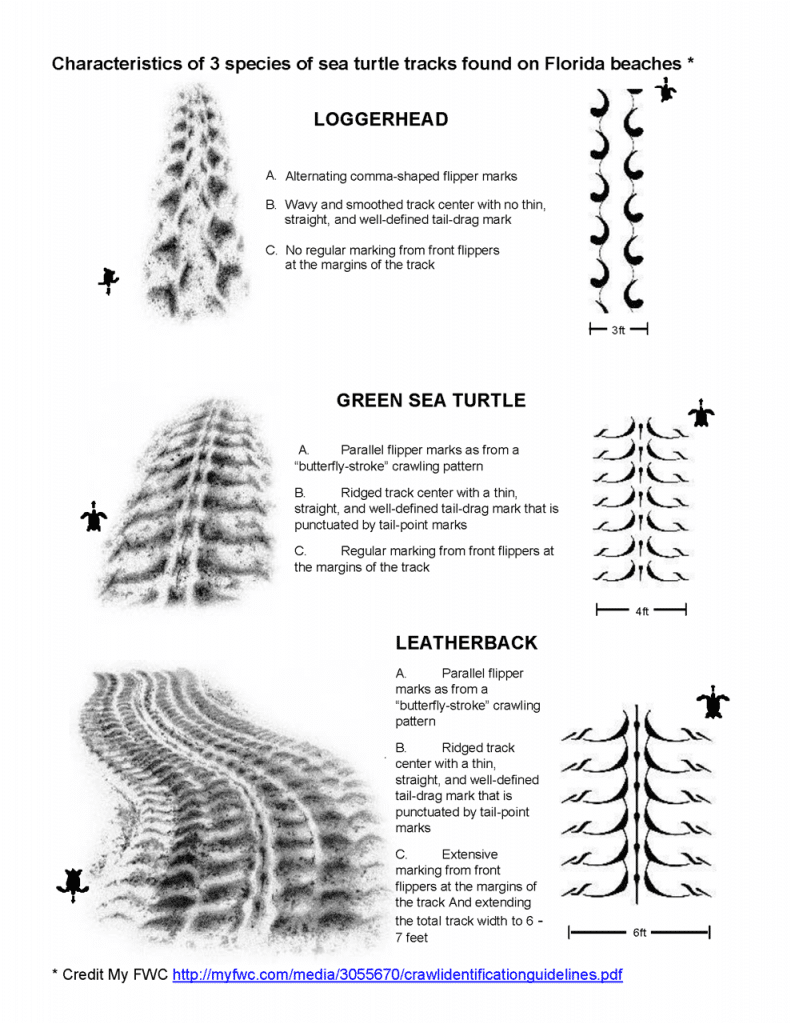
Cozumel Sea Turtle Hatching Process
While the nesting part is arguably the most important, the real fun begins when the sea turtle hatchlings start to emerge and scamper their way from the safety of the Cozumel turtle sanctuary beaches, and out into the open ocean.
After a couple of months of incubation under the sand, the baby turtles break their own way out of their shells, struggle out of the hole and down through the beach sand, navigating various obstacles, and head directly out into the water.
The sea turtle hatchlings can sense the direction of the water’s edge by heading for the brightest area, even though they usually begin this process just as the sun sets and into the evening. Any remaining sunlight or the moonlight reflecting off of the ocean surface is plenty for them to detect the direction of the shoreline.
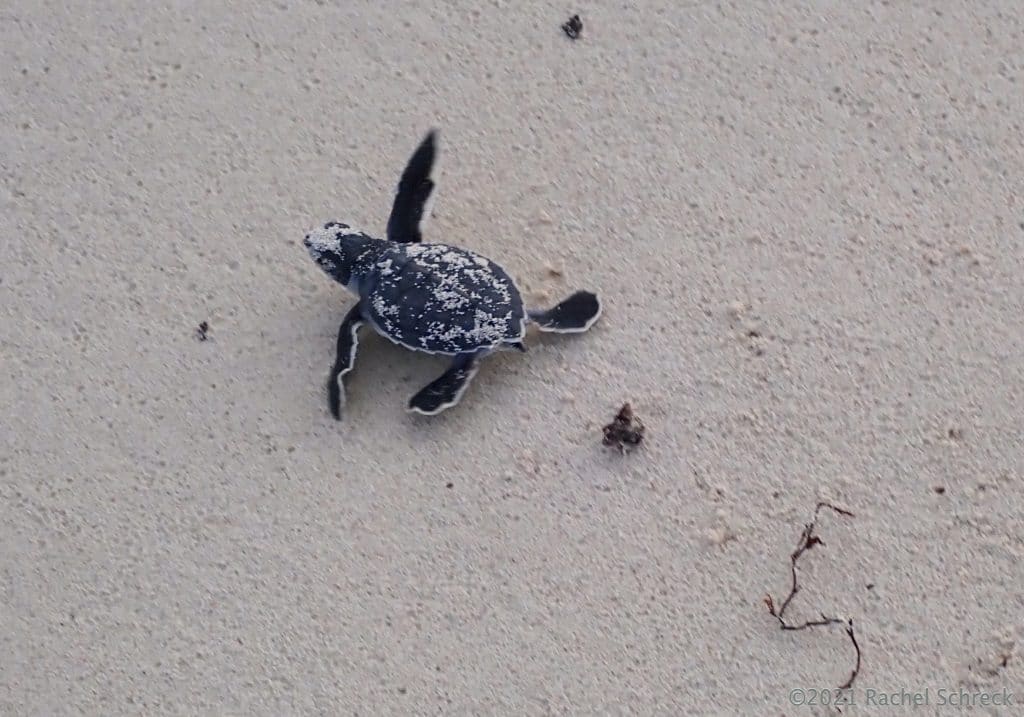
The Cozumel turtle hatching season and opportunities to volunteer to help the Cozumel turtle rescue efforts typically runs from very late July or early August, until the beginning of October.
The Cozumel Museum and Parks Department (FPMC) also runs and maintains the Punta Sur Eco Park on the southernmost tip of the island. Punta Sur Park has a large number of turtle nests each year, and these nests are tagged and recorded by marine biologists and assistant staff at the island’s official ecology department.
If you are visiting or living here during these months, and want to volunteer with Cozumel turtle rescue staff to help with site clearing and preservation, you can pitch in with this program through a joint effort between the FPMC and the ecology department scientists.
They are also happy to receive donations of money or materials (red headlamps, large permanent markers, etc.) to keep the program going.
A typical volunteer session will involve you taking a van or bus down to Punta Sur Park, and observing as the staff members return to certain nests they’ve recorded earlier by date and coordinates, and that should be fully incubated and ready to hatch. They can usually find at least one or two that are active or candidates for their assistance.
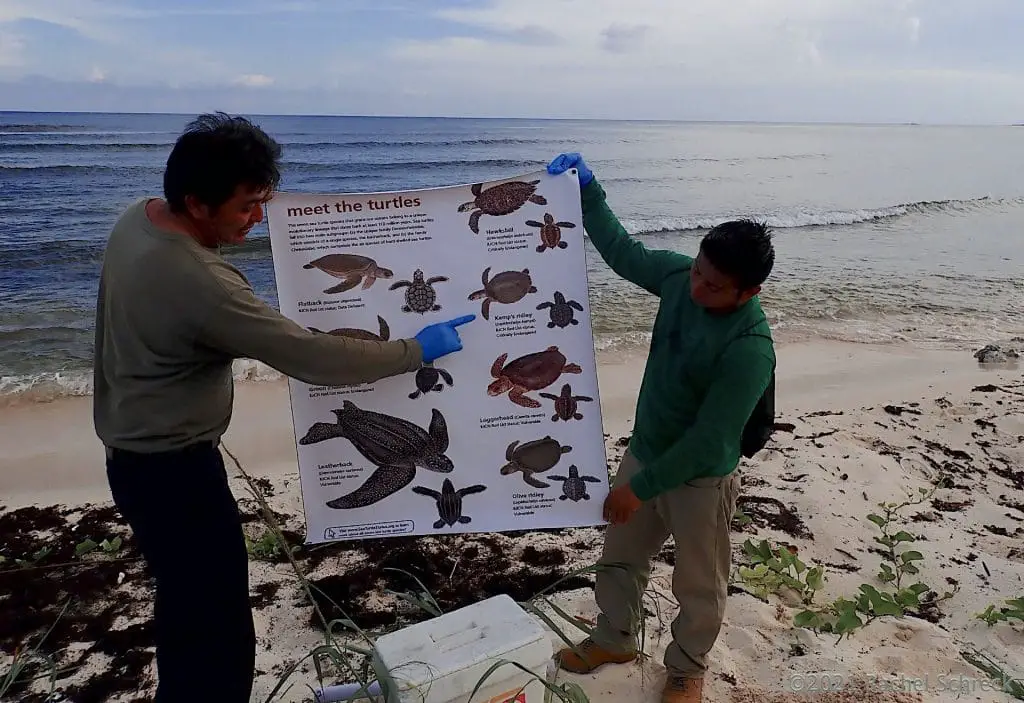
Meanwhile, you’ll spend some time doing a beach clean-up, by collecting any plastic pollution you and your group can find in a small patch of shoreline. (The last time I did this we, unfortunately, collected about 3 or 4 large garbage bags worth, in just half an hour).
Once a nest is selected and deemed ready, you will help create a clear path for the little hatchlings – moving sticks, rocks, and any bunches of seaweed or other things that could trip them up. Then the ecology crew removes some of the top layers of sand to make it easier for the new hatchlings to start their push to the top, and their mad dash to the waterline.

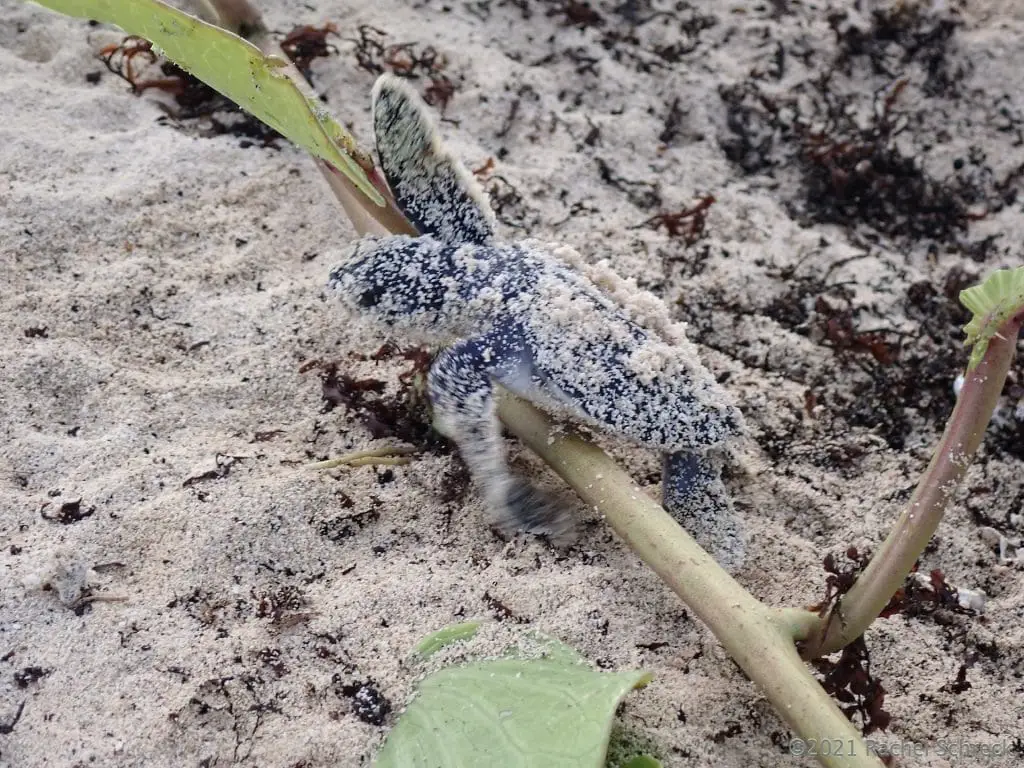
The trained crew and the nightly volunteers can watch and photograph, but should refrain from touching them unless it’s essential – and then it’s done with a sanitary and gloved hand.
Sometimes a new turtle hatchling might get flipped over, tangled in grass or seaweed, or blocked by a rock or some beach trash that was missed. In those cases, intervention is preferable to letting one fail to reach the ocean.
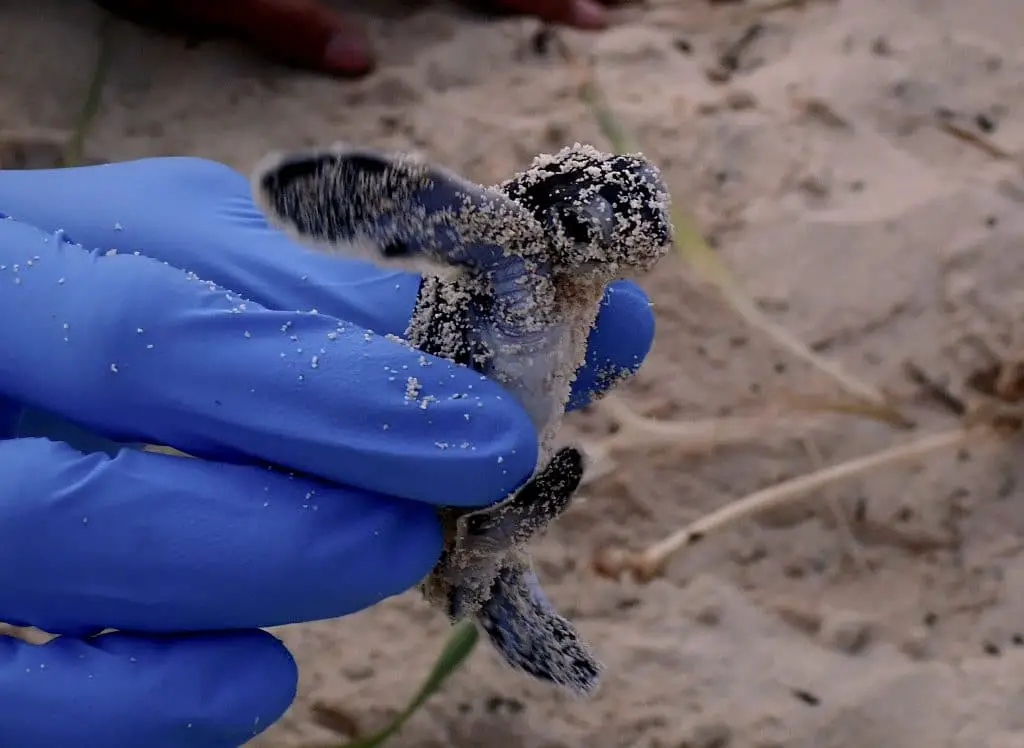
It’s really hard not to want to help them even more, but this is all part of their process.
The process that will hopefully allow them to quickly gain the skills of survival, and ultimately the process that will allow mature female marine turtles to use the Earth’s magnetic fields as sensory navigation guides when returning to this very same beach to lay their own eggs.
Again, this is all via the sea turtles’ incredible life-cycle phenomenon know as natal homing.

If you’re planning your trip around this inspiring experience in the early Fall, here’s an article all about what else is going on in Cozumel around that time.
Cozumel’s Sea Turtles Are All Endangered Species
As mentioned at the beginning of this article, all seven remaining sea turtle species are considered endangered by various international wildlife organizations, and are included as endangered or vulnerable – and “decreasing” – on the highly regarded IUCN Red List of Threatened Species.
The IUCN (International Union for Conservation of Nature and Natural Resources) was established in 1964 to monitor and guide global conservation, and is widely considered “the world’s most comprehensive information source on the global extinction risk status of animal, fungus, and plant species.”
The hawksbill sea turtle and the Kemp’s ridley sea turtle are currently listed as “critically” endangered by the IUCN.
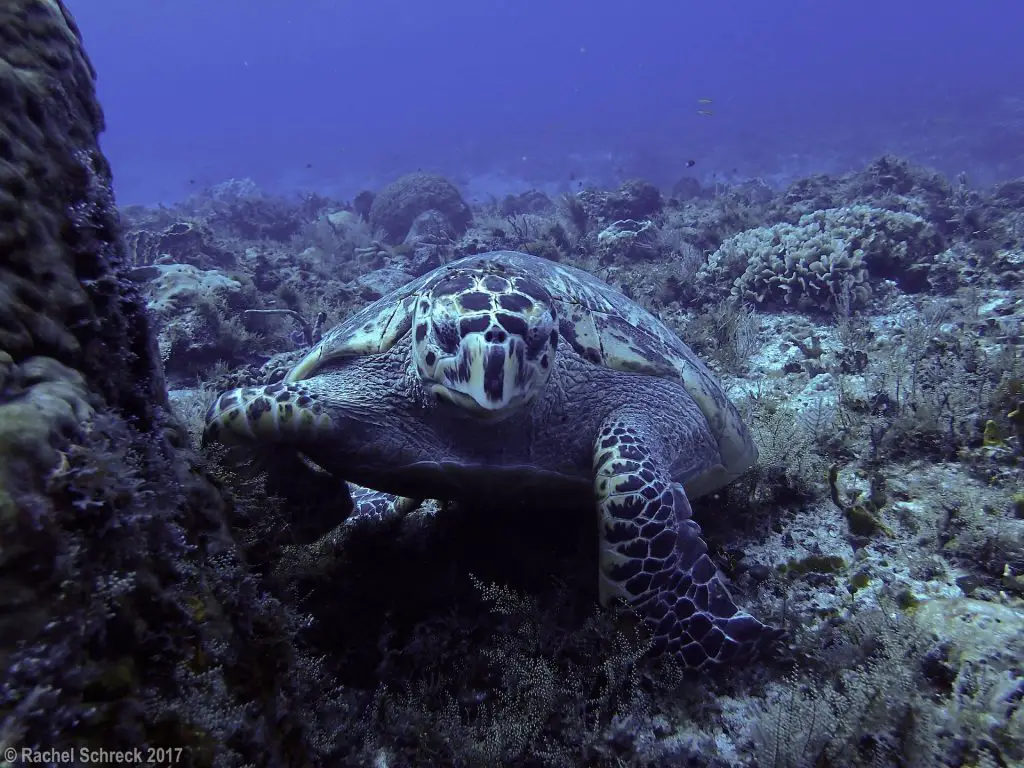
The main sea turtles found in Cozumel – the hawksbill, green, and loggerhead – are of course included in this global endangered status.
Main Threats to Sea Turtle Populations
Unfortunately, the main threats to different sea turtle populations are man-made.
According to the World Wildlife Foundation, the biggest hazard to sea turtles is entanglement in large-scale fishing gear. The turtles are either caught in the nets as “bycatch” and unable to reach the surface to breathe, or are caught up in the nets and damaged in other ways.
A global problem of discarded or broken fishing gear has also increased in recent decades, creating what are known as “ghost nets” littering the ocean. Turtles are often caught and tangled in these, as well.
Sea Turtles are also threatened by the loss of habitat, through coastal development. Turtles are also poached, harvested, and illegally sold and traded for their meat, their symbolic meaning in religious ceremonies, or the decorative beauty of their shells.

In fact, the critically endangered hawksbill sea turtle’s beautiful shell has the color and markings most closely associated with “tortoiseshell” jewelry and hair adornments. The traditional and ongoing lust for such natural, decorative materials is strongly to blame for the hawksbill’s tenuous status.
Again, the trade of sea turtle shells is supposed to be forbidden under the UN’s CITES treaty. Nevertheless, illegal poaching and trading still occur.
This 2019 article by National Geographic uses new data to really analyze and expose the several million hawksbill turtles that have been exploited over decades for their shells, alone. This ongoing black market trade, along with habitat losses and other threats, has left the hawksbill sea turtle critically endangered.
Climate Change Creates Specific Threats to Sea Turtles
Finally, various climate conditions threaten the well-being of all sea turtle species.
One major issue with a warming Earth is that it can affect the temperatures at which deposited turtle eggs, as described above, are incubated for the months they are buried at various natal beach sites.
The sex of each egg is not predetermined, and as they develop during the incubation period, warmer temperatures tend to produce more females than males.

With a general warming trend, the ratio of new males to females can become out of balance, leading to a decline in reproduction.
Further, surface conditions like the disruption of the northern jet stream will likely continue to cause major storms and coastal erosion. These can disrupt the turtles’ natal beaches, and disrupt their access to foraging material, among other things.
Just recently in 2021, the U.S. was captivated by the incredible images of some 5,000 cold-stunned turtles along the Gulf of Mexico’s Texas coastline being rescued and warmed up indoors during Texas’ unexpected arctic cold-snap, as you can see from this AP NEWS image of cold-stunned turtle rescue effort in Texas, February 2021.
Plastic pollution also presents a real threat to sea turtles, especially given that jellyfish are a main staple in a sea turtle’s diet, and yet they cannot always distinguish between a jellyfish and a clear plastic bag.
And we’ve all seen that video of the turtle and the straw, amIright?
Let’s clean up after ourselves so these beauties have more of a fighting chance.
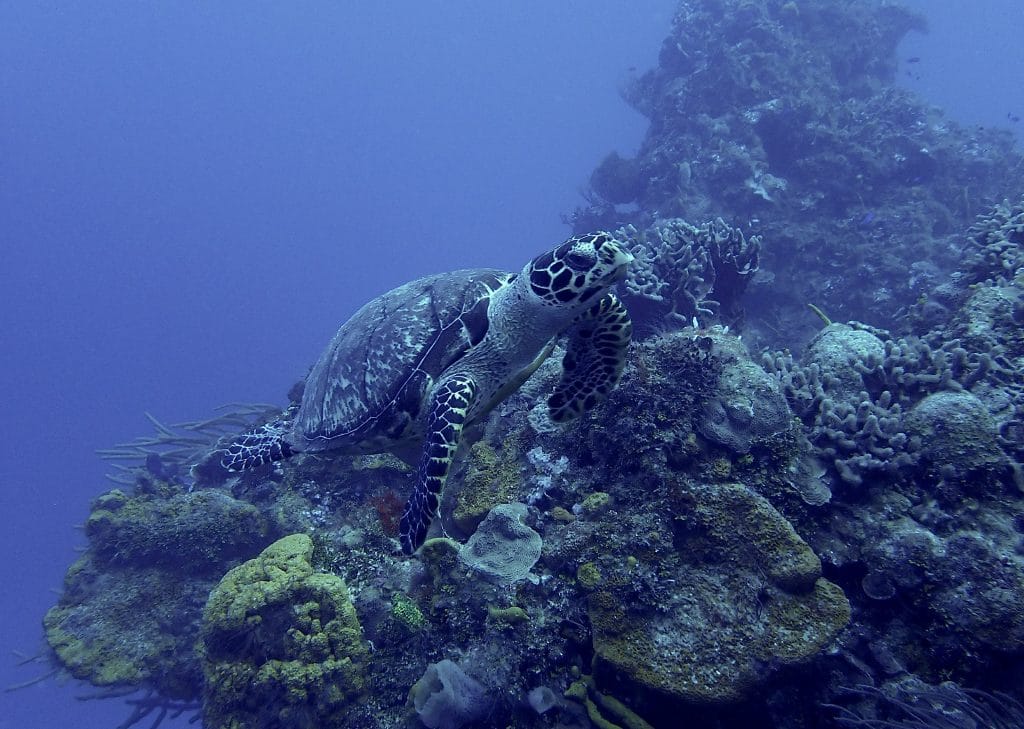
To read about other aspects of our great Cozumel diving, check out other articles in this category, here, and sign up for our monthly newsletter up in the upper right of this page.
And if you’re interested in getting into
- Easy to use
- Easy to pack
- Easy on the wallet
- Durable, waterproof, dustproof



